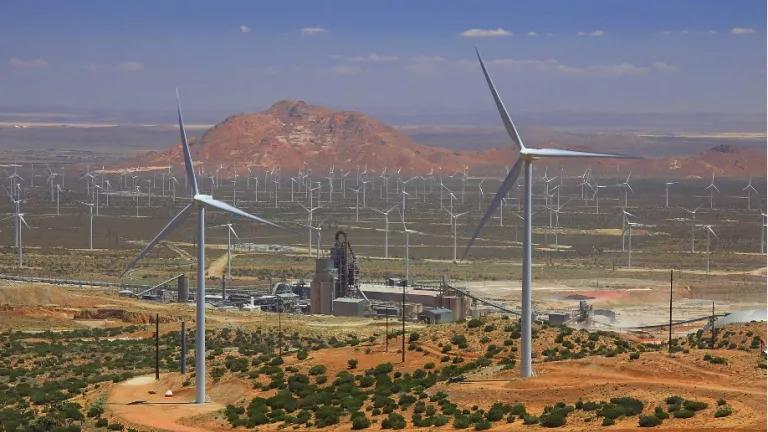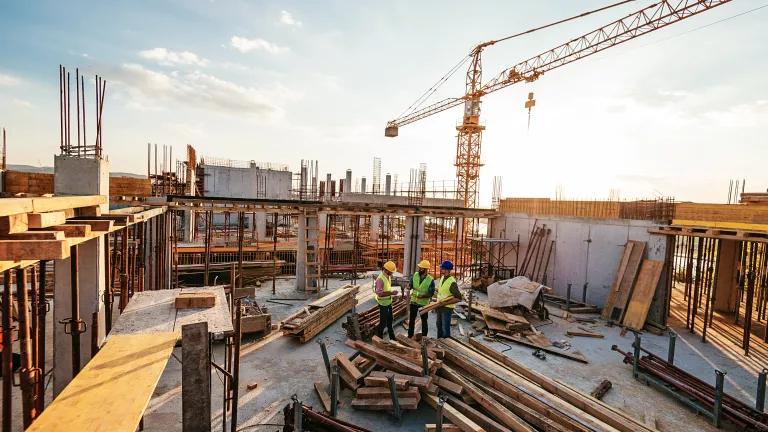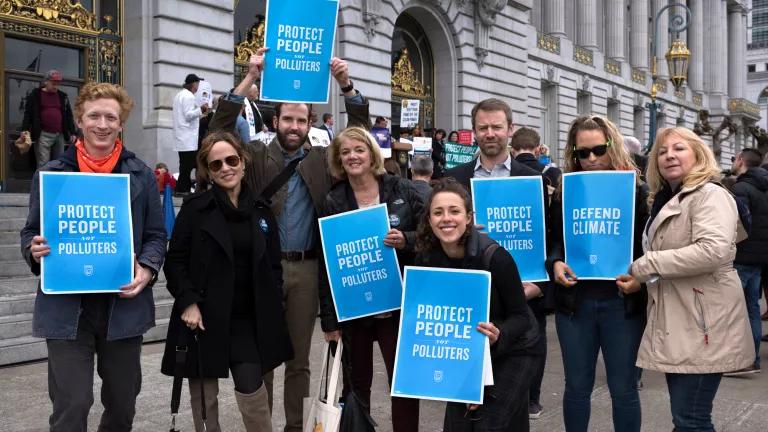California Can Pave the Way on Decarbonizing Cement
Following a law enacted in 2021, all cement used in California will need to reach net zero emissions by 2045.jaden

California’s cement plant in the Mojave desert announced in 2022 that it is switching to production of a lower-carbon cement (Source: CalPortland)
Part of NRDC’s Year-End Series Reviewing 2022 Climate & Clean Energy Developments. Co-authored with Jaden Kielty.
California has taken on the important work of reducing carbon emissions from the cement industry. Following a new law enacted in 2021, all cement used in California will need to reach net zero emissions by 2045, at the latest. Since then, the state’s leading environmental agency—the California Air Resources Board (CARB)—has been laying the foundation for a strategy to reach that goal and it’s no small feat: California is the second largest cement producing state and its seven cement plants are old and heavily reliant on coal.
Looking ahead, 2023 will be a pivotal year as CARB determines how to implement a comprehensive strategy with potential implications for other climate leadership states, the United States, and cement producers globally.
Why tackle cement emissions?
Cement kilns burn limestone, clay, and fossil fuels to manufacture solid grey lumps known as clinker. Clinker is then ground up with small quantities of gypsum to make cement—the grey powder that when mixed with sand, gravel, and water binds all these materials together and hardens to form the most widely used material on earth: concrete.
This process is so carbon intensive that even though cement makes up less than 15% of concrete by weight, it accounts for 90% of concrete’s carbon footprint. Cement is now the second-largest industrial source of carbon pollution in the state after oil and gas production, meaning California cannot ignore cement emissions. Neither can the rest of the world. Globally, cement accounts for roughly 8% of all greenhouse gas emissions, and demand for cement is growing.

Cement making is very carbon intensive due to process emissions and reliance on fossil fuels. Cement is responsible for the vast majority of emissions in the final product - concrete.
With the passage of SB 596, which NRDC sponsored, California took a ground-breaking step to zero out emissions from cement produced and used in the state by no later than 2045. Carbon emissions in cement manufacturing come from both the actual process of creating cement, which releases carbon and other chemicals, and the fuels burned to conduct this process. As a result, to zero out emissions from cement, CARB will need to rely on a suite of interventions.
Achieving this ambitious goal will require action on two parallel tracks: speeding the cement industry’s uptake of existing solutions and, at once, working to de-risk emerging technologies critical for deeper decarbonization.
So, how will we get there?
CARB is the first jurisdiction seeking to comprehensively answer that question. That’s why what happens on the path to decarbonizing cement in California has the potential to serve as a model for other U.S. states and major cement producing countries around the world.
NRDC outlined the key policy levers that CARB and other key decisionmakers and stakeholders in California must prioritize in a public comment to CARB, submitted jointly with RMI in late November. Here is a summary of our main recommendations.
1. Use less clinker
The single most impactful, near-term solution for reducing cement emissions is by simply using less clinker and replacing it with lower-carbon alternatives. We can alter the recipe for cement and replace some of the clinker with lower-carbon alternatives like calcined clay, ground limestone, or natural pozzolans. We can also alter the recipe for concrete by replacing traditional cement with other materials like fly ash, steel slag, or ground glass—commonly known as supplementary cementitious materials (SCMs)—which have been used in moderation for decades because of their lower cost. So far, however, adoption of blended cements and higher SCM mixing ratios in concrete has been languid due to long regulatory approval times for new cements and market skepticism.
To support greater adoption of blended cements, CARB must prove that alternative cements perform as well a traditional Portland cement in applied projects. CARB will need to collaborate with the California Department of Transportation (CalTrans) to promote an efficient evaluation and approval process for lower-carbon cement blends. Demonstration projects using blended cements with high clinker replacement ratios can help build an evidence base of project successes to increase confidence and familiarity for stakeholders across the value chain whose buy-in is necessary for broader market adoption.
Smart public procurement policies for low carbon concrete are also critical, since state agencies in California are enormous concrete purchasers for public works projects in the state. Such policies would signal to project developers and concrete producers to a) use less cement in their ready-mix concrete; and b) look for cements with lower embodied CO2 emissions. Other states have moved forward on low carbon concrete procurement, but California currently lags behind.
2. Leverage federal and state funding to de-risk emerging technologies
Deep decarbonization will require that we quickly de-risk and deploy nascent but promising technologies. Prime among them is kiln electrification, which is still in early stages of development yet has the potential to eliminate combustion emissions from cement manufacturing. Currently, the energy-intensive cement production process in California relies on two of the dirtiest fossil fuels—coal and pet coke—and the alternatives available pose pollution risks. Kiln electrification would not only eliminate carbon emissions but also reduce harmful on-site air pollution. CARB should seek to leverage existing federal and state funding to advance kiln electrification through its pre-commercial development phases.
The Inflation Reduction Act (IRA) provides $5.8 billion for direct investment in industrial decarbonization. NRDC and our partners recently sent a letter to DOE urging the agency to use these funds, in part, to support first- through third-of-a-kind commercial scale demonstration projects that feature transformative process technologies, such as electric cement kilns. Additionally, the California Energy Commission (CEC) has budgeted $100 million in funding for industrial facilities to purchase and deploy electrification technologies.
Carbon capture and storage (CCS)—the process of capturing CO2 and storing it permanently underground—is another emerging technology that will likely be necessary to fully decarbonize cement production. California is the first state to establish responsible CCS deployment requirements through legislation in 2022, which NRDC supported (SB905). Building a few early projects demonstrating CCS on cement plants will be an important proving ground for these complex decarbonization technologies, and is another area where federal IRA funding, combined with state incentives and robust safeguards, could be transformative.
Looking ahead
California’s work is defining a credible pathway to zero out cement emissions and deliver the package of incentives and standards necessary to build first-of-a-kind decarbonization projects on the ground. CARB’s strategy, expected to be published by July 2023, will inform work in other jurisdictions and lower costs and deployment barriers to adoption of critical advanced technologies, both in the United States and beyond.
CARB must rally together agencies, the legislature, and relevant stakeholders to adopt these existing and emerging solutions. California continues to be a national leader in industrial decarbonization, and the rest of the world should keep an eye on the state for early lessons on emission reductions in cement production. In the cement sector, 2045 is only one investment cycle away.
The real work starts now!





